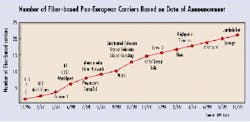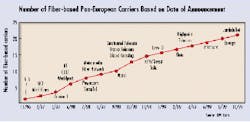Pan-European network opportunities spark fierce competition
By Robert Pease
In the wake of deregulation in Europe, the fiber-optic telecommunications industry is booming, perhaps at a faster pace than in the post-deregulated United States. KMI Corp., an independent consulting firm based in Newport, RI, draws several similarities and differences between the two regions.
As in the U.S. telecommunications market, there is a rapid entry of new operators into newly deregulated markets. In fact, since May 1998, at least 21 carriers have become fiber-based pan-European carriers, all vying for shares in a market some reports say will grow to $225 billion by 2001. Consolidation among carriers is also prevalent, as the acquirer seeks to rapidly enter into new markets, gain access to customers, and increase its economies of scale to reduce costs.
The differences between the two market regions are the speed at which entrants are entering the market and the sheer number of entrants establishing a network presence in Europe. The expansion into Europe by these new market entrants is part of a global strategy to provide seamless connectivity to under-served markets at the lowest cost per bit.
KMI's report, "Networks of Fiber-Based Pan-European Carriers: Market Developments and Forecast," also points out that although the most attention has focused on intercity backbone installations, a lot of activity has been erupting in the metropolitan-area-network (MAN) arena. Research indicates the number of pan-European fiber-based MANs has grown more than 80% since 1995, from just five in 1995 to 55 in 1999. In 1999 alone, 35 MANs were deployed, an increase of 338% over 1998. New providers such as Metromedia Fiber Network (New York City), Level 3 Communications Inc. (Broomfield, CO), Global TeleSystems Group Inc. (GTS-McLean, VA), and VersaTel Telecom N.V. (Netherlands) are fueling the dramatic increase in MAN deployment, along with long-time metropolitan network operators like COLT Telecom Group plc (London) and MCI Worldcom Inc. (Jackson, MS).
The development of pan-European fiber-optic networks may offer huge growth opportunities for operators and increase the likelihood of "the death of distance." But not without a cost, says Ovum in its latest report, The Pan European Carrier Market: The Emergence of a New Model. "The opportunity will bring about fierce competition that could leave some operators bleeding by the wayside," says Ovum's Rebecca De Coster, co-author of the report. "Still, carriers are grasping the opportunity with both hands."
The availability of cost-effective, cross-border service on the continent has caused exploding demand, and network operators want to cash in. The cost savings to carriers and businesses operating in multiple countries is considerable when compared to the artificially high tariff structure and interconnection costs prior to deregulation. Ovum predicts that total cross-border bandwidth demand in Europe will reach over 9 Tbits/sec by 2005, up from 339 Gbits/sec in 2000, and will be driven by Internet and corporate data services.
As demand increases and more carriers enter the European market, a marked increase in kilometers of fiber is also evident and expected to increase, according to KMI's report. Fiber counts are also on the rise as new entrants are using higher-fiber-count cables of 72, 96, 120, and 144. GTS, for example, prefers low fiber counts and maximizes bandwidth by offering capacity by wavelength. On the other side of the spectrum, Interoute Telecommunications Ltd. (London) has announced the highest fiber count, averaging 384, for its I-21 network.There is also considerable range in terms of geographical presence of the fiber-based pan-European carriers. In route-km, Eurotunnel Telecoms Ltd. (London) is currently the smallest network at 360 route-km and Interoute's I-21 is the largest at 20,900 route-km. When all 21 carriers complete the current network builds, Europe will be criss-crossed by approximately 165,610 route-km of fiber cable, representing nearly 16 million fiber-km, according to KMI's research.
With all this fiber and all these carriers flooding the European market, competition is already increasing and, according to Ovum, Europe is still an opportunistic target for even more entrants.
Emerging carriers that are basically using similar technologies and competing for the same routes will inevitably lead to competitive pricing in the short term, particularly in the wholesale and carriers' carrier markets. Interestingly, Ovum believes there will ultimately be space for less than 10 operators acting as the main providers of long-distance transport in Europe. Consolidation is likely to occur when some network plans currently in place either flounder in the marketplace or require modification.
Who will ultimately succeed in Europe is the million-dollar question. According to Ovum, the ability to offer end-to-end services to multinational customers between the world's major cities on a single, wholly owned network will be a key source of competitive advantage in the future market's environment. Being successful in Europe could ultimately relate to success in the other two major telecommunications markets-North America and Asia-Pacific.
KMI also believes success is related to the global environment. With the global reach of multinational corporations came the requirement to provide new technology that transmitted data and Internet content more efficiently than 64-kbit/sec voice circuits. This requirement meant building networks from the ground up using data-efficient networks such as frame relay, Asynchronous Transfer Mode, and Internet protocol (IP) and using nonzero dispersion-shifted fiber optimized for dense wavelength-division multiplexing (DWDM). The goal of using these newer technologies is to become the low-cost provider and thereby attract customers in an increasingly competitive global environment.

